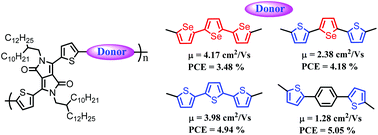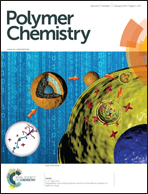Diketopyrrolopyrrole-based copolymers bearing highly π-extended donating units and their thin-film transistors and photovoltaic cells†
Abstract
New diketopyrrolopyrrole (DPP)-based π-extended conjugated polymers containing relatively long conjugated donor monomers were successfully synthesized in order to investigate their physical properties and device performance in thin-film transistors and photovoltaic cells. The solubility of the polymers was improved via side-chain engineering, and relatively high molecular weights were achieved by modifying the synthetic procedures. The highest occupied molecular orbital and the lowest unoccupied molecular orbital and optical bandgaps of the polymers were easily tuned by incorporating different donor monomers with different donating abilities. All polymers were highly crystalline with a predominant edge-on orientation on the substrate. The polymers displayed different hole mobilities in TFTs depending on the donor monomer. The highest mobility was 4.17 cm2 V−1 s−1, which was shown by the TFT fabricated with a terselenophene-containing DPP polymer after thermal annealing. Furthermore, bulk heterojunction organic photovoltaic cells made from a blend film of the polymers and (6,6)-phenyl C71-butyric acid methyl ester demonstrated promising device performance with power conversion efficiencies in the range of 3.48–5.05%.


 Please wait while we load your content...
Please wait while we load your content...